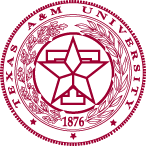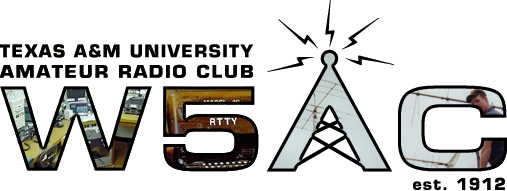



Search:
Callsign lookup:
APRS Locator:
(Type * after callsign for locations that might include a number suffix)
The amateur radio club at AMC* was founded and licensed in 1912. The club has been on campus ever since, making it one of the oldest university radio clubs in existence.
* Agricultural & Mechanical College of Texas, which would become Texas A&M University in 1963
The club's name during the early days was some variation of "Texas A&M College Radio Club." Early records show that we once made our transmissions from Bolton Hall, the Electrical Engineering building at the time. We were there at least until the construction of the MSC in the 1950's. We contacted 9 different countries in 1926 alone, not to mention the thousands of U.S. contacts in the logbooks. We've been affiliated with ARRL since June 10, 1924.
The "First Radio Broadcast of Football Game", detailed on this page, was made possible by William A. "Doc" Tolson and others, and it is his picture which has become famous in association with that broadcast. After October 7, 1922, public broadcasts at the college were made from the callsign WTAW, which is still in use commercially (off campus) today. Amateur radio continued at 5XB, which changed its callsign to become W5AC today. While some say the call letters WTAW were chosen to spell "Watch The Aggies Win", the letters TAW are also the reverse of "Doc" Tolson's initials!
As history (and one of our logbooks) shows, amateur radio transmissions were suspended during World War II. After the 1960's, the club was known as the "MSC Radio Committee". We are currently housed in the Memorial Student Center, as we have been for decades. We moved temporarily to Bizzell Hall in the early 1970's during remodeling of the MSC, at which time we installed our antennas on the Goodwin Hall tower that then held TAMU's weather radar. We've been located above the bowling alley and apparently in a guest room of the MSC hotel, among other rooms. In Fall of 1983, we moved from room 152 on the first floor of the west side of the building (next to offices of the Texas A&M Board of Regents) on the third floor. We renamed our unique student organization to the current name, the "Texas A&M University Amateur Radio Club".
Our callsign has been W5AC since at least September 11, 1947. Former calls for W5AC include:
* On this date, "W" prefixes were added to existing amateur radio callsigns in the continental U.S. to identify them internationally.
Pictures of past QSL cards for those callsigns are below.
First play-by-play radio broadcast of a football game -- Texas A&M electrical engineering students participated in the first play-by-play broadcast of a football game between Texas A&M and Texas on Thursday, November 24, 1921. Using equipment in the Electrical Engineering Department, they transmitted plays by pre-arranged code via telegraph key.
Read more about the historic broadcast here.
In January of 1922, W5AC made a radio contact with Washington State using spark gap transmission, possibly setting a world record for that mode. By 1926, spark transmission was prohibited for use by hams, superceded by CW transmission.
W5AC's first FM repeater on 146.82 MHz was built around 1971 by
Bob Switzer W5IUP. It was tested in the apartment of W5XTT (then WB5BCT) and
his XYL, KD5OGM. The transmitter was connected to a coat hanger hung
from the roof of the 1 story apartment, with a Ringo about 35 feet up
for the receive antenna.
After testing, the transmit antenna was placed
on the elevator of Kyle
Field, while the receive antenna was on the MSC bell tower some distance
away (no need for duplexers). They were linked with a private phone
line that cost only $24 per year - a clever application of TAMU phone
policy by W5AC members at the time.
Starting in late 1973, the repeater was located
at the KAMU-TV Channel 15 tower (A&M's PBS broadcast station) just north of
campus. Due to various interference problems, the repeater was
apparently moved
in late 1978 to Rudder Tower (from club records). In the summer of
1994, the repeater moved from a temporary location at our shack in the
MSC back to Rudder Tower. Then, in February 2005, the repeater was
moved to the 13th floor of the O&M (Oceanography and Meteorology)
building on campus.
On March 23, 1973, Texas A&M and the University of Texas (or as we like
to call our rivals, "t.u.") competed in a game of chess. The chess clubs
of each school communicated their moves via amateur radio (3.950 MHz SSB
and also two meter AM locally on the Austin end). Apparently the Aggies
won this match. Click for images of the QSL card (front) and (back).
Thanks to N5XU for use of the images, originally captioned with the
following:
"Tnx QSO es setting up chess match on your end - gig 'em!"
writes Dave WA5ZRB. Postage at the time was eight cents.
On May 2, 1974, W5AC transmitted a 65-foot long telegram to that university in Austin, via Radio Teletype (RTTY). The telegram was signed by "a large cross-section of students", and took 8 W5AC members 4 hours to transmit. Extremely long telegrams were a frequent activity of W5AC around that time, often sent to the Fish Drill Team when they were at the national drill competition in Washington, D.C. The Model 19 machine would run radio teletype (RTTY) on the 20 meter band for hours, breaking every 10 minutes to send identification. Similar telegrams made their way to Aggies playing basketball in Austin in the late 1970's, covered with the names of students on campus wishing them well - another demonstration of "Aggie Spirit".
W5AC played a crucial part in the yearly construction of Bonfire in the decades before cellphones were practical. Cut sites that were 70 miles from A&M could only contact main campus via HF amateur radio. Even ambulances might be outside the range of line-of-sight radios at "cut", and ham radio would be the fastest way to get medical attention to anyone injured there. Beginning in 1978, W5AC would host a special event - "CQ Bonfire" - during the burning of Bonfire, which attracted many former students.
Our past Field Day activity is here.
Besides awards and emergency communication (EmComm) service listed below, we've also assisted the TAMU Ocean Drilling Program's JOIDES Resolution Drill Ship communicate back home to Aggieland while at sea.
In the recent past, W5AC rebroadcasted NASA Select TV Audio to 147.54 MHz during shuttle missions. We don't at this time, because of the new schedule format of NASA TV.
W5AC also used to announce DX spots on 145.59 MHz with "EGOR," which was a PC connected to a 2 meter transmitter. EGOR is now dismantled, a victim of a nearby lightning strike.
Though the club's former presence on packet radio diminished years ago (with the internet boom), we are currently working towards a new packet radio network, for use during (and between) emergencies.
Below are some of the awards that the club has earned, and emergencies to which W5AC provided assistance.
| Additional Countries Worked | ||||
|---|---|---|---|---|
| 110-160 on 12/13/68 |
170-180 on 2/3/70 |
190-210 on 3/15/71 |
270 on 6/27/88 |
280 |